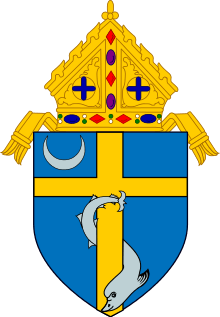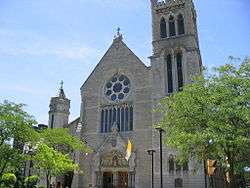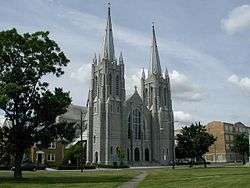Roman Catholic Diocese of Syracuse
| Diocese of Syracuse Dioecesis Syracusensis | |
|---|---|
 | |
| Location | |
| Country | United States |
| Territory | 5,479 square miles (14,190 km2) in Central New York (Counties of Onondaga, Oneida, Broome, Chenango, Cortland, Madison, and Oswego, New York) |
| Ecclesiastical province | Archdiocese of New York |
| Statistics | |
| Population - Total - Catholics |
(as of 2014) 1,198,000 289,000 (24.1%) |
| Parishes | 129 |
| Schools | 22 |
| Information | |
| Denomination | Roman Catholic |
| Rite | Roman Rite |
| Established | November 26, 1886 |
| Cathedral | Cathedral of the Immacculate Conception |
| Secular priests | 223 |
| Current leadership | |
| Pope | Francis |
| Bishop | Robert Joseph Cunningham |
| Metropolitan Archbishop |
Timothy M. Dolan Archbishop of New York |
| Vicar General | Timothy S. Elmer |
| Emeritus Bishops | Thomas Joseph Costello |
| Map | |
 | |
| Website | |
| syracusediocese.org | |
The Diocese of Syracuse is a Catholic diocese headquartered in Syracuse, New York, United States. The current bishop is the Most Rev. Robert J. Cunningham. The Roman Catholic Diocese of Syracuse includes 237,546 Catholics residing in seven counties of Central and South Central New York State. The seven counties are Broome, Chenango, Cortland, Madison, Oneida, Onondaga and Oswego.
History
Within the area that now makes up the Diocese of Syracuse, missionary activity was first recorded in 1654. During a brief truce between the French and the Iroquois, French Jesuit Simon Le Moyne, eloquent in Huron and Iroquois languages, departed from Quebec City to the upper Mohawk valley. On 16 August of that year, the Onondagas showed him a spring that they believed to be cursed, but which he immediately recognized as a salt spring.[1] Upon his return, Pierre-Joseph-Marie Chaumonot and Claude Dablon laid the groundwork to build Sainte Marie among the Iroquois in 1656, a sizable mission which housed about 7 Jesuits and 50 French workmen. This group had to abandon the mission 2 years later to avoid a threatened massacre by Mohawks. Additional missions were undertaken by Jesuits and Sulpicians.
Meanwhile, the nearby Dutch proprietary colony of New Netherlands fell to the English in 1664, and again in 1667. Almost immediately, the English and French began to dispute the territory that was inhabited by the Iroquois. Both sides incited their Indigenous allies to raid the allies of the other, leading to rivalries, atrocities, and reprisals, making it difficult to maintain and continue missions.
Several decades later, the colonial legislature under Governor Bellomont ushered in harsh penal laws that threatened to fine, imprison, and even execute Catholic priests found not only in parts of New York controlled by the British, but the disputed areas as well.[2] The last Jesuit missionary to the Iroquois surrendered at Albany in 1709.[3] Great Britain gained full legal control over this territory with the signing of the Treaty of Paris (1763) at the conclusion of the Seven Years' War.
The American Revolution and the ratification of the First Amendment finally removed the legal impediments to practice the Catholic faith. Nevertheless, it took many decades before Catholic churches would be built in central New York. There were very few Catholics settled there, and only a small number of them could make the journey to Albany or New York City to attend Mass. Among them were John C. Devereux, first mayor of Utica, who was a member of the board of trustees of St. Mary's Church in Albany, and Dominick Lynch, founder of Rome, New York, who was one of the signatories of an address of congratulations by the Catholics of the United States presented to George Washington upon his election.[2]
The population of Catholics swelled when teams of Irish Catholics arrived to construct the Erie Canal, and also when the opening of the canal increased trade, commerce, and additional immigration. Rev. Paul McQuade, pastor of St. Mary's Church in Albany from 1813 to 1815, frequently visited Utica, and probably celebrated Masses there in private homes. The first public Mass in the city of Utica was celebrated in the Courthouse on 10 January 1819.[2]
The advent of railroads brought an ever-increasing number of immigrants to Syracuse. The decision was made to form the diocese of Syracuse, which took place on 20 November 1886. Rev. Patrick Anthony Ludden, former vicar general of the Diocese of Albany, was named bishop, and St. John the Evangelist Church was selected to serve as the first cathedral. Bishop Ludden built a new cathedral, Immaculate Conception, and consecrated it on 25 September 1910.
Bishops
The list of ordinaries of the diocese and their years of service:
- Patrick Anthony Ludden (1886-1912)[4]
- John Grimes (1912-1922)
- Daniel Joseph Curley (1923-1932)
- John A. Duffy (1933-1937), appointed Bishop of Buffalo
- Walter Andrew Foery (1937-1970)
- David Frederick Cunningham (1970-1975)
- Francis James Harrison (1977-1987)
- Joseph Thomas O'Keefe (1987-1995)
- James Michael Moynihan (1995-2009)
- Robert Joseph Cunningham (2009–present)[5]
High schools
- Bishop Grimes Junior/Senior High School, East Syracuse
- Bishop Ludden Junior/Senior High School, Syracuse
- Notre Dame Junior Senior High School, Utica
- Seton Catholic Central High School, Binghamton
See also
- Index of Catholic Church articles
- List of the Catholic dioceses of the United States
- List of Roman Catholic archdioceses (by country and continent)
- List of Roman Catholic dioceses (alphabetical) (including archdioceses)
- List of Roman Catholic dioceses (structured view) (including archdioceses)
 |
|
References
- ↑ "Le Moyne, Simon". Dictionary of Canadian Biography.
- 1 2 3 "Syracuse". Catholic Encyclopedia.
- ↑ "Mareuil, Pierre de". Dictionary of Canadian Biography.
- ↑ "History of the Diocese of Syracuse", 1909, p. 25.
- ↑ Diocese of Syracuse website
External links
Coordinates: 43°02′45.7″N 76°08′58.7″W / 43.046028°N 76.149639°W

